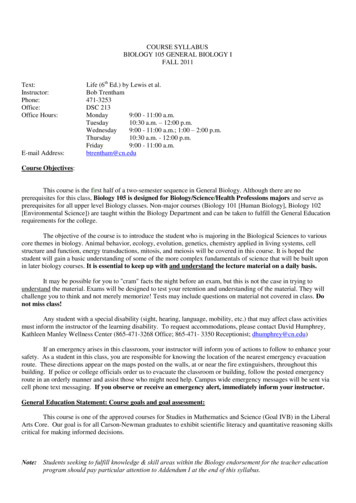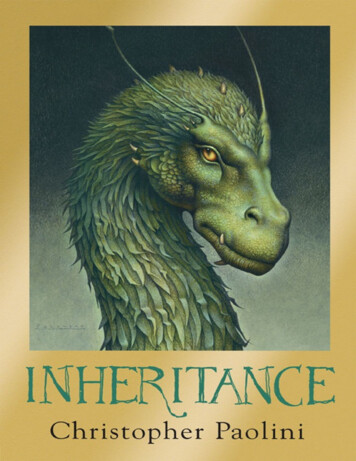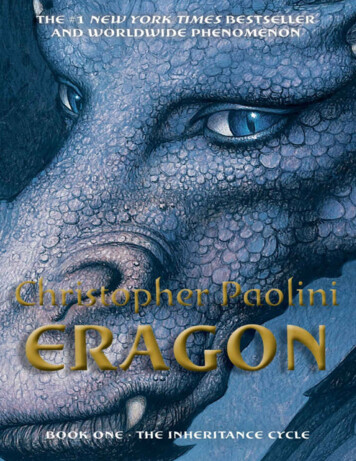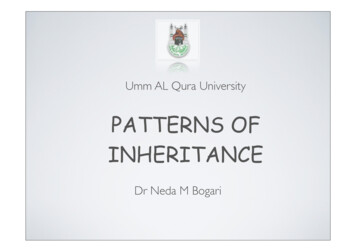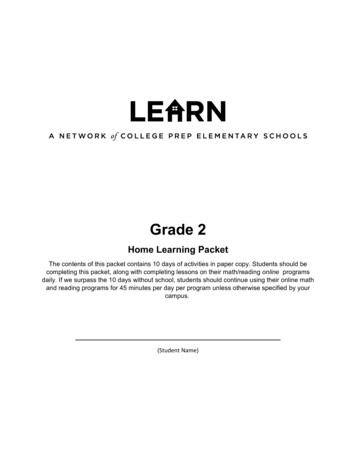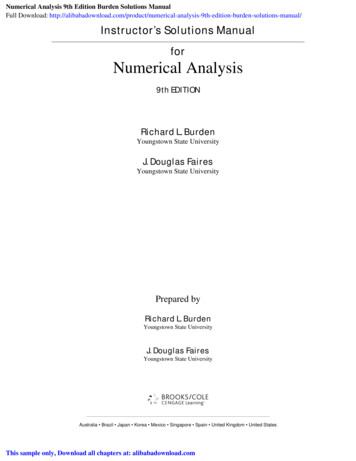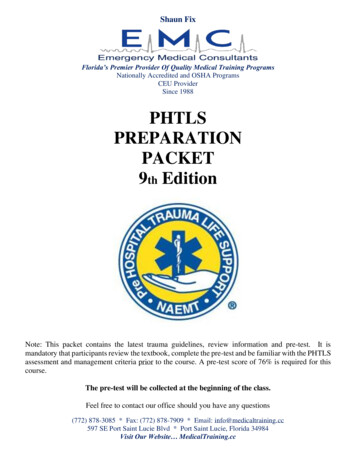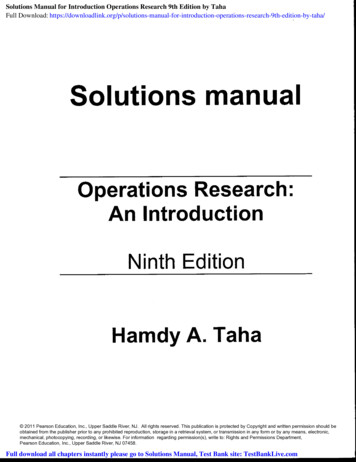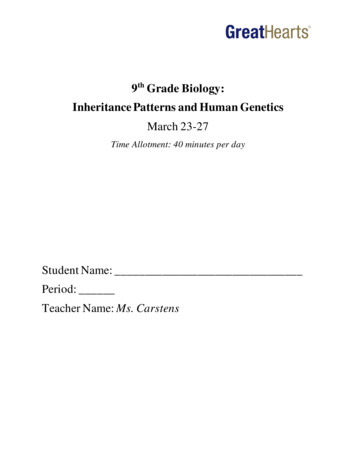
Transcription
9th Grade Biology:Inheritance Patterns and Human GeneticsMarch 23-27Time Allotment: 40 minutes per dayStudent Name:Period:Teacher Name: Ms. Carstens
9 th Biology – Patterns of Inheritance and Human GeneticsMarch 23-27Packet OverviewDateObjective(s)Page NumberMonday, March 231. Differentiate between sex chromosomes andautosomes.2. Identify how X- and Y-linked genes affectinheritance.2Tuesday, March 241. Describe how X- and Y-linked genes affectthe inheritance of traits.2. Explain the effect of crossing-over on theinheritance of genes in linkage groups.71. Differentiate between chromosomemutations and gene mutations.2. Identify types of mutations.121. Identify the significance of using pedigreesto determine genetic traits and disorders.2. Identify inheritance patterns and factorsaffecting them.181. Identify and describe genetic disorders.2. Identify and describe types of geneticdisorder treatment.26Wednesday, March 25Thursday, March 26Friday, March 27Additional Notes: Textbook pages for readings are scanned and found in this packet. See each day’sinstructions for the page numbers of the reading for that day. A minor assessment is found on the last two pages of this packet, pp. 32-33. On Friday,after completing the assignment for the day, you will complete this minor assessmentreviewing the unit. You may use your notes from the week. It should take approximately12-15 minutes.Academic HonestyI certify that I completed this assignmentindependently in accordance with the GHNOAcademy Honor Code.I certify that my student completed thisassignment independently in accordance withthe GHNO Academy Honor Code.Student signature:Parent signature:1
9 th Biology – Patterns of Inheritance and Human GeneticsMarch 23-27I.Monday, March 23Unit – Ch 12: Inheritance Patterns and Human GeneticsLesson 1: Chromosomes and Inheritance (Part 1)Unit Overview:In our next unit of biology, we will study chromosomes and their unique role in inherited traits as well asinheritance patterns in human genetics. We will explore research that led to the discovery of sexdetermination, sex-linked genes and traits, and linked genes. We will also differentiate between varioustypes of mutations, identify conditions that can lead to these mutations, and explore preventativemeasures and therapies associated with the treatment of diseases and disorders that result from mutations.As we begin this unit, it is important to remember what we have learned from previous lessons aboutDNA. First, recall that DNA is a nucleic acid formed by monomers called nucleotides, each consisting ofa nitrogenous base (adenine, thymine, cytosine, guanine), a sugar called deoxyribose, and a phosphategroup. These monomers are structured in long, patterned strands and are matched with a complementary,antiparallel strand, creating a double-helix structure.We also know that chromosomes are structures composed primarily of an organism’s DNA found in thecytoplasm of a prokaryotic cell and in the nucleus of a eukaryotic cell. Human beings contain 23 pairs ofchromosomes (46 total), with one chromosome in each pair provided by the mother and the otherprovided by father. Having pairs of chromosomes results in organisms having two or more alternativeforms of a gene, called alleles, for each inherited trait. Dominant trait alleles mask recessive trait alleleswhen present in a pair together. In fact, recessive traits only appear when both alleles are recessive. Theseallele pairs are passed to the offspring when a male gamete (sperm) and a female gamete (egg), producedin meiosis, are joined together during fertilization.Finally, we understand that when meiosis and fertilization occur correctly and DNA is replicated,transcribed and translated accurately, an organism’s chromosomes provide information for geneexpression and the production of proteins that help carry out an organism’s life functions. However,mistakes in any of these processes can lead to complications such as mutations. Mutations can be to thebenefit of an organism, of no significance to an organism or can place an organism at a disadvantage,potentially harming it.Objectives: Be able to do this by the end of this lesson.1. Contrast sex chromosomes and autosomes.2. Identify how an individual’s sex is determined.Introduction to Chapter 12 - Lesson 1In this first lesson, you will read about the research of a scientist named Thomas Hunt Morgan. Hisexperiments surrounding the common fruit fly (Drosophila melanogaster led to discoveries andobservations of the X- and Y-chromosomes as well as X- and Y-linked traits. In addition to Morgan’sresearch, you will read about how an organism’s sex is determined.Read and annotate pages 235-236 from your text (found on pgs. 4-5 in this packet). After readingand annotating, complete the guided outline and questions on the following page.2
9 th Biology – Patterns of Inheritance and Human GeneticsMarch 23-27GUIDED OUTLINE: Chromosomes and Inheritance (pp. 235-236) Chromosomes and Inheritance Chromosomes Early Work Thomas Hunt experimented within the early 1900s. Each fly had pairs of chromosomes. Three of the pairs were; one pair differed in and X- and Y-chromosomes are calledHow are X- and Y-chromosomes different? Sex Chromosomes and Autosomes Sex chromosomes – contain genes that determine the of anindividualAutosomes – remaining chromosomes that Interpreting Figure 12.2, p. 236. How are human female and male karyotypes similar?How are they different? Sex Determination In mammals, how does the individual become male? How does the individual becomefemale?Using the Punnett Square below, cross a male (XY) and a female (XX) to determine theratio of male to female offspring.Female : Male3
9 th Biology – Patterns of Inheritance and Human GeneticsMarch 23-27FOR USE DURING AT-HOME INSTRUCTION SPRING 2020 ONLY4
9 th Biology – Patterns of Inheritance and Human GeneticsMarch 23-27FOR USE DURING AT-HOME INSTRUCTION SPRING 2020 ONLY5
9 th Biology – Patterns of Inheritance and Human GeneticsMarch 23-27Closing: Check your understanding of the lesson by answering the following question in 4-6 sentences.1. How are human chromosomes similar to that of other species? How are they different? (Provide at leasttwo similarities and at least one difference.)6
9 th Biology – Patterns of Inheritance and Human GeneticsMarch 23-27II.Tuesday, March 24Unit – Ch 12: Inheritance Patterns and Human GeneticsLesson 2: Chromosomes and Inheritance (Part 2)Lesson 2 Socratic Guiding Question: Keep this question in mind as you study!What impact did Morgan’s research have on our understanding of inheritance and human genetics?Objectives: Be able to do this by the end of this lesson.1. Describe how X- and Y-linked genes affect the inheritance of traits.2. Explain the effect of crossing-over on the inheritance of genes in linkage groups.Introduction to Lesson 2From the unit introduction, recall that sex chromosomes are formed during meiosis. In previous lessons,you also learned that during fertilization in humans, gametes (male and female sex cells) combine toprovide the offspring with 23 pairs of chromosomes. In your lesson yesterday, we discovered that 22 pairsof chromosomes in humans are identical, but one pair differs between males and females. In today’slesson, you will be exploring genes and traits associated with this difference. You will also continue todelve into Morgan’s research and observations regarding what he called “linked genes.” Our finaldiscovery informs you of a tool called a chromosome map, developed by researchers, and how it impactsthe study of genes.Read and annotate pages 237-238 from your text (found on pgs. 9-10 in this packet). After readingand annotating, complete the guided outline and questions below.GUIDED OUTLINE: Chromosomes and Inheritance (pp. 236-237) Effects of Gene Location Describe the experiment and data that led Morgan to further his research on sex-linked genes andtraits. (See Fig. 12-3 for assistance) Sex-Linked Genes and Traits Based on the results from the research data above, Morgan hypothesized that the gene for eyecolor in fruit flies is carried on the , while the Y chromosomean allele for the eye-color gene X-linked chromosomes are found on the Y-linked chromosomes are found on the Explain why there are more X-linked traits.7
9 th Biology – Patterns of Inheritance and Human GeneticsMarch 23-27 Explain why a male who carries a recessive trait on the X chromosome will exhibit a sex linked trait. Linked Genes Morgan called pairs of genes that tend to be inherited together; he called a set of these a Morgan hypothesized that genes are linked because Because mutations are rare, Morgan inferred that the process ofduring meiosis must be responsible for the linked genes. Chromosome Mapping What is a chromosome map? Why is it useful for scientists? The crossing-over for two traits is to thebetween them on a chromosomeComplete the following: Sex-Linked Punnett Square Practice1. A woman without hemophilia marries a man with hemophilia. They have a daughter with hemophilia.What is the genotype of the mother and father?2. A colorblind man marries a female who is a carrier for colorblindness. What is the probability that th eywill have a child who is colorblind?8
9 th Biology – Patterns of Inheritance and Human GeneticsMarch 23-27FOR USE DURING AT-HOME INSTRUCTION SPRING 2020 ONLY9
9 th Biology – Patterns of Inheritance and Human GeneticsMarch 23-27FOR USE DURING AT-HOME INSTRUCTION SPRING 2020 ONLY10
9 th Biology – Patterns of Inheritance and Human GeneticsMarch 23-27Closing: Check your understanding of the lesson by answering the following question in 4-6 sentences.1. Why is Morgan’s research significant to the study of inheritance patterns and genetics? What did heobserve and discover regarding what we know of chromosomes and inheritance?11
9 th Biology – Patterns of Inheritance and Human GeneticsMarch 23-27III.Wednesday, March 25Unit – Ch 12: Inheritance Patterns and Human GeneticsLesson 3: Chromosomes and Inheritance (Part 3)Objectives: Be able to do this by the end of this lesson.1. Differentiate between chromosome mutations and gene mutations.2. Identify types of mutations.Introduction to Lesson 3In Chapters 10-11, we were introduced to mutations. Recall that a mutation is a change in the nucleotidebase sequence of a gene or DNA molecule. We also know that mutations can be to the benefit of anorganism, of no significance to an organism or can place an organism at a disadvantage, potentiallyharming it.In today’s lesson, we will be exploring the differences between mutations that can occur in body cells aswell as in reproductive cells. We will also be looking into specific mutations that can occur inchromosomes and in genes.Read pages 239-240 from your text (found on pgs. 14-15 in your packet). As you read, highlight thevarious mutations and complete the following tasks found below and on the next page. Usecomplete sentences the answer the questions.GUIDED NOTES: Mutations – pgs. 239-240 There are three categories of mutations:CategoryDefinition/DescriptionGerm-cell mutation Mutation that occurs in an organism’s body cells CAN affect the organism itself, but CANNOT be inheritedin offspring Examples: human skin cancer, leukemiaLethal mutations How do some beneficial mutations give an organism and evolutionary advantage? Within the three categories, mutations can occur as mutations or asmutations, or point mutations.12
9 th Biology – Patterns of Inheritance and Human GeneticsMarch 23-27 Chromosome mutations involve changes in the of a chromosome orthe or of a chromosome. Types of chromosome mutations (See Figure 12-6 for visuals):Chromosome MutationDescriptionDeletion A chromosomal segment breaks off, flips aroundbackward, and reattachesTranslocationNondisjunction Down syndrome is a result of a chromosome mutation. What type of chromosome mutationcauses Down syndrome and how Down syndrome occurs in an individual? A point mutation, or gene mutation, is the ,, or of a single nucleotide within agene or other segment of DNA on a chromosome. Types of point mutations (See Figure 12-7 for visuals):Point MutationDescription/Result of SubstitutionFrameshift mutationInsertion mutation13
9 th Biology – Patterns of Inheritance and Human GeneticsMarch 23-27FOR USE DURING AT-HOME INSTRUCTION SPRING 2020 ONLY14
9 th Biology – Patterns of Inheritance and Human GeneticsMarch 23-27FOR USE DURING AT-HOME INSTRUCTION SPRING 2020 ONLYPractice/Closing: Check your understanding of the lesson by completing the following:1. Differentiate between a chromosome mutation and a point mutation. How are they alike? How are theydifferent?15
9 th Biology – Patterns of Inheritance and Human GeneticsMarch 23-272. Use the Codon Amino Acid chart below to complete the practice mutation problems FIRST. Thencheck your work with the key found on the following page.Mutations PracticeYou have read about several types of mutations: DELETION (a base is lost/deleted) INSERTION (an extra base is added/inserted)---Deletion and insertion may cause what’s called a FRAMESHIFT mutation, meaning thereading “frame” of RNA changes, thus changing the amino acid sequence from that pointforward SUBSTITUTION (one base is substituted for another)Complete the following boxes below. Classify each as Deletion, Insertion, or Substitution16
9 th Biology – Patterns of Inheritance and Human GeneticsMarch 23-27MUTATIONS PRACTICE KEY:17
9 th Biology – Patterns of Inheritance and Human GeneticsMarch 23-27IV.Thursday, March 26Unit – Ch 12: Inheritance Patterns and Human GeneticsLesson 4: Human Genetics (Part 1)Lesson 4 Socratic Guiding Question: Keep this question in mind as you study!What is the significance of studying pedigrees?Objectives: Be able to do this by the end of this lesson.1. Identify the significance of using pedigrees to determine genetic traits and disorders.2. Identify inheritance patterns and factors affecting them.Introduction to Lesson 4Recall from your study of the fundamentals of genetics that traits are inherited by offspring from parents.Each of these traits is a combination of two or more alleles to form the gene for that given trait. Allelescan be dominant or recessive, and genes can be homozygous (consisting of two of the same alleles for atrait, such as TT or tt) or heterozygous (consisting of two different alleles for a trait, such as Tt).In this lesson, we will discover how the use pedigrees, or patterns of inherited traits within generations offamilies, help scientists better understand how traits are passed from one generation to the next, whatgenes control specific traits, and how these genes control traits.Read and annotate pages 241-245 from your text (found on pgs. 21-25 in this packet). After readingand annotating, complete the guided outline and questions below.GUIDED OUTLINE: Human Genetics (pp. 241-245) Human Genetics Inheritance of Traits Geneticists can study human genetic traits and trace genetic diseases/disorders through thegenerations by studying the phenotypes of family members in a pedigree Pedigrees Define pedigree – Fill in the following key that is typical for a pedigree: Squares – Circles – Filled symbol – Empty symbol – Horizontal line – Vertical line –Why do you think pedigrees are helpful?18
9 th Biology – Patterns of Inheritance and Human GeneticsMarch 23-27 Patterns of Inheritance Complete the following statements: If a trait is autosomal,. If a trait is sex-linked,. A carrier is an individual that has copy of theallele but does not have the . Genetic Traits and Disorders Genetic disorders are diseases or disabling conditions that have a. Polygenic Inheritance Most human characteristics are characters, meaning they areinfluenced by genes List four examples of human characteristics that are influenced by polygenic characters: Complex Characters – characters that are strongly both bythe and by . Identify two human characteristics that are considered complex characters. Why are theyconsidered complex characters? Biologists hope that by identifying environmental components that contribute to adisease, they can educate people in ways that minimize their risk of developing thedisease.Multiple Alleles Define the following: Multiple alleles – Codominance – Blood types are controlled by multiple alleles in humans: IA , IB , and .19
9 th Biology – Patterns of Inheritance and Human GeneticsMarch 23-27 Incomplete Dominance occurs when X-Linked Traits Identify an X-linked trait in humans:Why are these traits typically seen more commonly in males? Sex-Influenced Traits and females can show different evenwhen they share the same genotype. Example: Pattern baldness – due to higher levels of testosterone, males experience patternbaldness more than womenSingle-Allele Traits A single allele of a gene controls single-allele traits More than human traits have been discovered to be governed by singlealleles.Closing: Check your understanding of the lesson by completing the following question.1. What is the significance of genetic study through the use of pedigrees? (3-5 sentences)20
9 th Biology – Patterns of Inheritance and Human GeneticsMarch 23-27FOR USE DURING AT-HOME INSTRUCTION SPRING 2020 ONLY21
9 th Biology – Patterns of Inheritance and Human GeneticsMarch 23-27FOR USE DURING AT-HOME INSTRUCTION SPRING 2020 ONLY22
9 th Biology – Patterns of Inheritance and Human GeneticsMarch 23-27FOR USE DURING AT-HOME INSTRUCTION SPRING 2020 ONLY23
9 th Biology – Patterns of Inheritance and Human GeneticsMarch 23-27FOR USE DURING AT-HOME INSTRUCTION SPRING 2020 ONLY24
9 th Biology – Patterns of Inheritance and Human GeneticsMarch 23-27FOR USE DURING AT-HOME INSTRUCTION SPRING 2020 ONLY25
9 th Biology – Patterns of Inheritance and Human GeneticsMarch 23-27V.Friday, March 27Unit – Ch 12: Inheritance Patterns and Human GeneticsLesson 5: Human Genetics (Part 2)Lesson 4 Socratic Guiding Question: Keep this question in mind as you study!What might be the advantages and the disadvantages of being able to detect genetic disorders in a fetus?Objectives: Be able to do this by the end of this lesson.1. Identify and describe genetic disorders.2. Identify and describe types of genetic disorder treatment.Introduction to Lesson 4As a result of mutations, inherited or not, individuals may be susceptible to developing genetic disordersand diseases. Knowing a person’s genetic makeup can help to determine their probability of passing ongenetic disorders to offspring or of developing a disease. Treatments for these genetic disorders anddiseases vary based on the severity of the symptoms and the conditions associated with the disorder ordisease.Read pages 245-248 from your text (found on pgs. 27-30 in this packet). After reading complete theguided outline and questions below. Detecting Genetic Disease What is amniocentesis? How is it useful? Using Table 12-1 on p. 246, list three examples of genetic disorders and describe the mutationsinvolved in them.Disorder:Mutation Involved:Disorder:Mutation Involved:Disorder:Mutation Involved: Genetic Counseling – the process of informing a person or couple of their. What might be the benefit of genetic counseling?26
9 th Biology – Patterns of Inheritance and Human GeneticsMarch 23-27 Treating Genetic Disease Physicians can treat genetic diseases in several ways. Treat symptoms through diets, medication, therapies, and lifestyle changes. Another level of treatment - gene therapy, which is a thatplaces a copy of a in the cells of a person whose copy of thegene is . Uses viruses by implanting the DNA into the virus to invade cells. Short-term success, but requires continuing treatments What is the difference between somatic cell gene therapy and germ cell gene therapy?FOR USE DURING AT-HOME INSTRUCTION SPRING 2020 ONLY27
9 th Biology – Patterns of Inheritance and Human GeneticsMarch 23-27FOR USE DURING AT-HOME INSTRUCTION SPRING 2020 ONLY28
9 th Biology – Patterns of Inheritance and Human GeneticsMarch 23-27FOR USE DURING AT-HOME INSTRUCTION SPRING 2020 ONLY29
9 th Biology – Patterns of Inheritance and Human GeneticsMarch 23-27FOR USE DURING AT-HOME INSTRUCTION SPRING 2020 ONLY30
9 th Biology – Patterns of Inheritance and Human GeneticsMarch 23-27The following two pages contain your minor assessment for the week andshould be completed on Friday only AFTER you have completed all previouswork in this packet. You may use your notes in this packet. It should take youapproximately 12-15 minutes.31
9 th Biology – Patterns of Inheritance and Human GeneticsMarch 23-27Minor Assessment: Chapter 12 – Inheritance Patterns and Human GeneticsDirections: Complete the following tasks. You may use your notes from this packet only.1. The two kinds of chromosomes in general are chromosomes and.2. Humans with the chromosomes XX are and XY are .3. A -cell mutation would only affect an organism during its lifetime.4. A -cell mutation would only affect an organism's offspring.5. The diagram represents the chromosomes of a person with a genetic disorder caused bynondisjunction. Which chromosome set displays nondisjunction?How do you know?6. Why are X-linked traits usually more commonly expressed in males?7. What are the benefits making and studying pedigrees? (Provide at least two.)32
9 th Biology – Patterns of Inheritance and Human GeneticsMarch 23-27Answer the following questions based on the information above.1. Which of Victoria’s sons had hemophilia?2. List Queen Victoria’s grandchildren who had hemophilia.3. Do any women shown above have hemophilia?4. List Queen Victoria’s children and grandchildren who were female carriers.33
Mar 09, 2020 · 9th Biology – Patterns of Inheritance and Human Genetics March 23-27 12 III. Wednesday, March 25 Unit – Ch 12: Inheritance Patterns and Human Genetics Lesson 3: Chromosomes and Inheritance (Part 3) Objectives: Be able to do this by the end of this lesson. 1. Differen

